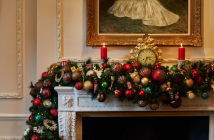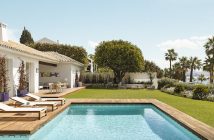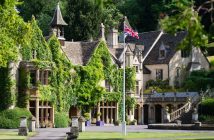“Mallorca is a truly beautiful island. In some places, it still feels as fresh as if the world had just been created,” so wrote Spanish Surrealist painter Joan Miró about the largest island in the Balearics. Settling there in 1956, Miró built a studio in Palma and, propelled by the purity of the light he encountered, produced a prolific amount of art while living on the island until his death in 1983. Another Spanish great more commonly associated with Barcelona – Catalan architect Antoni Gaudí – also left his mark on Mallorca having been enlisted to oversee the restoration of Palma’s gothic masterpiece, La Seu cathedral, in 1901. The sprawling structure had such an emotional effect on Argentine author Jorge Luis Borges that he wrote a poem in its honour while staying on the island in the ‘20s.
Over half of Mallorca’s population lives in Palma, which has enjoyed a rich and colourful past, having been colonised by the Phoenicians, the Romans and the Moors in the 10th century, when Palma became known as the Medina Mayurqua. In Roman times Mallorca’s economy was driven by olives, wine and salt. Today, its greatest exports are almonds, oranges and lemons, while tourism keeps the island afloat. Meaning ‘the larger one’ in Latin, Mallorca has a wildness to it that can’t be tamed. From its jagged coastline, pine-flecked bays and caves hiding subterranean lakes, what it lacks in pristine perfection it makes up for in charm.

Coves braid the island like beads and rugged cliffs dip down to sapphire seas framed by bone-white sand. Mallorca’s dramatic landscapes have inspired everyone from Agatha Christie, who wrote a collection of short stories set on the island after visiting in 1932, to Polish composer Frédéric Chopin, who visited with his French author lover George Sand during the winter of 1838 in the hope of soothing his weak lungs. Having his piano shipped over from Paris, Chopin finished his famous preludes here, and wrote that the island boasted, “A sky like turquoise, a sea like lapis lazuli, mountains like emerald, and air like heaven.”
Less showy than Ibiza, in recent years Mallorca has become a honeypot for well-travelled urbanites, who flock there to recharge in a restful environment. Championing this concept is the Puro Group. Founded in 2004 by eccentric Swedish entrepreneur Mats Wahlström, the Puro project began with the Purohotel in Palma, which Wahlström wanted to serve as a hub for ‘global nomads’ in a hat tip to his own peripatetic lifestyle. The hotel proved an instant hit and a year later Purobeach Palma followed, a chic beach club boasting a restaurant, spa, Balinese hammocks and a swimming pool carved from black volcanic rock.
The group has since opened beach clubs in Vilamoura in Portugal and Barcelona among others, and, most recently, back in its birthplace with the opening of Purobeach Illetas. Each of the sites incorporates local design elements to make it unique rather than a cookie-cutter replica of the original. Not ones to stand still, the company, led by Spanish CEO Beltran Alvarez de Estrada, has three new beach clubs in the pipeline for 2018, with openings slated for Crete in Greece, Taghazout Bay in Morroco and the Red Sea in Egypt. And if that level of expansion wasn’t dizzying enough, Estrada also has his sights set on Mexico and the Caribbean to make the Puro concept a truly global brand, and plans to open new Puro hotels in select sites around the world in the near future.

The launch of Purobeach Illetas drew a crowd of over 1,000 guests, including a smattering of Spanish celebrities, with deep house sets from resident DJ Sebas Ramis keeping the party people dancing until dawn. Feeding 1,000 guests verges on the biblical, but the scale of the task was impressively handled via abundant platters of saline oysters, flappingly fresh sashimi, melt-in-the-mouth pata negra jamón, silky slivers of Kobe beef carpaccio redolent with truffle oil, lime-laced sea bream ceviche and tooth-tinglingly sweet baklava.
Nestled among towering pines, to get to Purobeach Illetas you have to wind your way down a steep spiral staircase boasting breathtaking views of the sparkling turquoise Med, which is so inviting, it requires near superhuman strength not to dive right in and hope for the best. The site uses nature as its guide – its contours are crafted from the cliff edge and pure white parasols pop against the bright blue of the sea and sky. There’s even a secret bar inside a limestone cave where revelers can sink Patrón Margaritas into the small hours. During the day you can bronze yourself until you’re nut brown while sipping frozen strawberry daiquiris and watching the nearby sailboats bob to and fro in the welcome breeze. There is little to distract here from the pursuit of pleasure. Puro is a place where languorous stints on a sun lounger are encouraged.

If you can muster the strength to dress for lunch, you’ll be rewarded with the likes of Bloody Mary linguini, salmon and avocado tiradito, and fish tacos with chipotle mayo. The Puro Group has created its own ‘M3’ dining concept based around the myriad of diverse cuisines found in Melbourne, Miami and Marrakech, with Melbourne bringing an Asian influence, Miami modernity and Marrakech a bohemian twist. Among the wines on pour at Puro is an elegant, ballet shoe pink, melon-scented rosé made from local grapes Mantonegro and Callet.
While it doesn’t shout about it, Mallorca is home to a clutch of boutique wineries, including 4Kilos, whose oenologist creates alchemy with Callet, Mantonegro and Fogoneu in a converted sheep farm, so it’s worth sniffing out local wines during your visit. Those who find it hard to do nothing can mount a paddleboard and wade around the Med all afternoon, or indulge in a spot of beachside yoga. As the sun dips the music gets louder, especially during Puro’s famous full moon parties featuring live house sets from resident DJs.

In pursuit of purity, Purohotel goes big on white. The building itself is dazzlingly white and contrasts dramatically with Mallorca’s bright blue canopy of sky, which is a joy to wake up to each morning. Stone, leather, wood and water also play a key role in interior architect Jaime Oliver’s design aesthetic, which is calming rather than quirky with its clean lines and palate of grey and white. A silver bowl filled with apples waits expectantly in the lobby for guests to pilfer from, while in the spa you’ll be slathered in wild peppermint and sage oil then lulled to sleep by expert hands.
Starting life as a home from home for travelling Swedes, the hotel has expanded from 24 to 51 rooms but retains its boutique feel – 60% of the clientele are regulars. The minimal aesthetic extends to the bedrooms, with their grey curtains and quilted beige headboards, where a screen door leads to a giant stone shower filled with luxurious Molton Brown products like pink pepperpod shower gel. The ‘macro’ bar meanwhile, is stocked with 70cl bottles of Dan Aykroyd’s Crystal Head vodka and Colombian rum La Hechicera.
A word of warning – Purohotel is for music lovers rather than those seeking silence. Retiring to my room overlooking the main courtyard at 1am, it felt like I’d fallen asleep next to a loud speaker as the house music thumped through the building until 2am.  “We’re a club hotel; a little mad house where people come to be themselves. We’re keen to attract discerning travellers who want to feel like a local wherever they go,” enthuses the hotel’s ebullient Italian manager Giovanni Merello, whose latest plan is to go big on brunch, offering feasts on the rooftop to a lounge music soundtrack. The hotel’s Opio restaurant specialises in fusion cuisine, while the beach clubs adhere to the group’s ‘M3’ dining concept, offering the likes of bao buns stuffed with pork and peanut, ceviche served inside limes, and grilled octopus with aioli.
“We’re a club hotel; a little mad house where people come to be themselves. We’re keen to attract discerning travellers who want to feel like a local wherever they go,” enthuses the hotel’s ebullient Italian manager Giovanni Merello, whose latest plan is to go big on brunch, offering feasts on the rooftop to a lounge music soundtrack. The hotel’s Opio restaurant specialises in fusion cuisine, while the beach clubs adhere to the group’s ‘M3’ dining concept, offering the likes of bao buns stuffed with pork and peanut, ceviche served inside limes, and grilled octopus with aioli.
With its shaded courtyards, darting swifts and dreaming spires, an afternoon amble around the narrow streets of Palma’s old town is a must. Painted in earthy tones and prettified with green shutters, the buildings feel more Italian than Spanish. Another nod to Italy are Palma’s ice cream parlours, which entice you at every turn with their pastel-coloured treats. Those keen to see Palma in a hurry can do so by walking along the wide Passeig des Born, which cuts through the main artery of the city like La Rambla in Barcelona, offering soothing shade from its avenue of trees whose bowed branches meet in the middle.
The Puro Group’s symbol is the Mandala, which can be found dotted around the hotel and beach clubs if you look out for it. Featuring prominently in an intricate wood carving behind Purohotel’s reception desk, the flower represents purity and enlightenment, as the delicate lotus blossoms in murky waters. Given the turbulent times we’re living in, the need to escape the darkness of daily life is becoming all the more important, and Puro’s resorts offer just that; an oasis of calm that lifts us from the stresses of our increasingly mad world.
For more on the Puro Group and its beach clubs, visit www.purobeach.com




